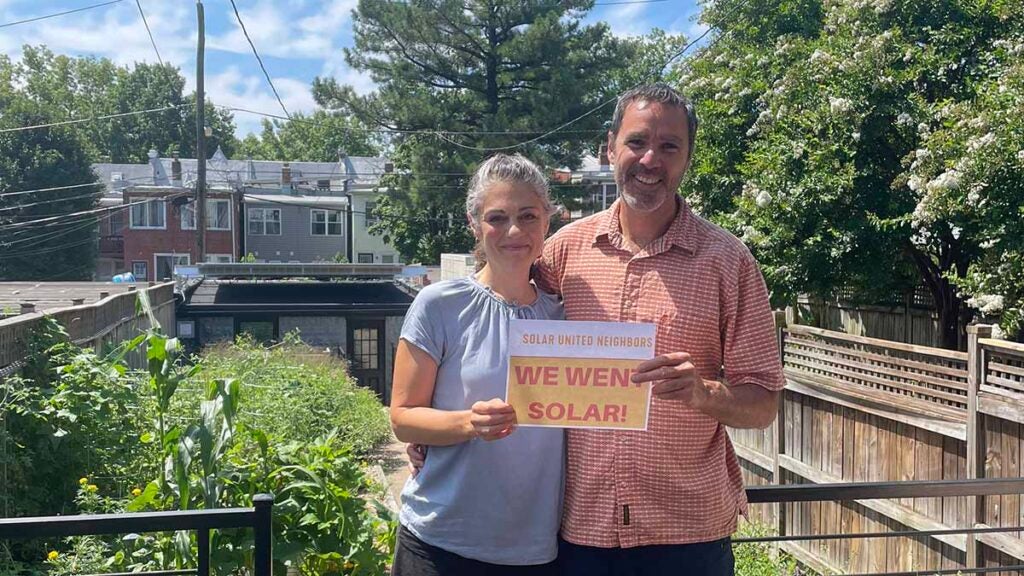How a new law in D.C. supports more distributed solar energy

So D.C. has a 100% renewable energy goal. What does that actually mean?
It’s a requirement for the local utility, Pepco. By 2032, all of the electricity the company sells must come from a renewable energy source, like rooftop solar.
Pepco can meet this requirement in two ways:
- It can contract for the purchase of electricity directly from renewable energy generators (e.g. a big wind farm in Pennsylvania), or
- It can buy solar renewable energy credits (SRECs) from individual producers (e.g. the solar panels on your roof)
If Pepco does not meet this requirement, it has to pay a fine. This fine is called an Alternative Compliance Payment, ACP for short. If the fine is too low, then Pepco will just pay the fine rather than buy more renewable energy or renewable energy credits.
Utilities like Pepco buy these credits on an open market, just like you would buy a stock or bond. Like any market, the price of credits depends on how much supply and demand there is for them. The ACP acts as a price ceiling. That is, the price of the credits will never go higher than the fine. This is because Pepco would pay the fine since it would be cheaper to do so than buy the credit.
How solar renewable energy credits (SRECs) boost your solar investment
Solar Renewable Energy Credits (SRECs) are sold separately from the physical electricity that your solar panels produce. Think of them like a “voucher” that proves that the electricity from your solar panels is renewable. You earn one SREC for every 1,000 kWh (or 1 MWh) of electricity produced by a solar system. A typical system produces five or six credits each year.
New law increases the value of SRECs
The new law increases the penalty Pepco must pay for missing their renewable energy target. It does so by increasing the compliance payments. This in turn makes SRECs more valuable.
Under the previous schedule, the compliance payment was set to drop to $400/MWh in 2024 and $300 in 2029, staying at $300/MWh through 2041. With the passage of B24-950, ACPs will follow a steady decline of $20/MWh annually, before leveling out at $300 from 2033 to 2041.
Over the life of a system, this could increase your return on investment for going solar by hundreds of dollars. The tables below show the impact of the new law.
Click here to learn how the new law benefits all D.C. residents.
New ACP & Solar Carveout Schedule
| Energy Year | % Solar requirement | Compliance payment cost (per MWh) |
|---|---|---|
| 2019 | 1.85% | $500 |
| 2020 | 2.18% | $500 |
| 2021 | 2.50% | $500 |
| 2022 | 2.60% | $500 |
| 2023 | 3.00% | $500 |
| 2024 | 3.65% | $480 |
| 2025 | 4.30% | $460 |
| 2026 | 5.00% | $440 |
| 2027 | 5.65% | $420 |
| 2028 | 6.30% | $400 |
| 2029 | 7.00% | $380 |
| 2030 | 7.65% | $360 |
| 2031 | 8.30% | $340 |
| 2032 | 9.00% | $320 |
| 2033 | 9.65% | $300 |
| 2034 | 10.30% | $300 |
| 2035 | 11.00% | $300 |
| 2036 | 11.65% | $300 |
| 2037 | 12.30% | $300 |
| 2038 | 13.00% | $300 |
| 2039 | 13.65% | $300 |
| 2040 | 14.30% | $300 |
| 2041 | 15.00% | $300 |
Old ACP & Solar Carveout Schedule
| Year | % Solar requirement | Compliance payment cost (per MWh) |
|---|---|---|
| 2019 | 1.85% | $500 |
| 2020 | 2.18% | $500 |
| 2021 | 2.50% | $500 |
| 2022 | 2.60% | $500 |
| 2023 | 2.85% | $500 |
| 2024 | 3.15% | $400 |
| 2025 | 3.45% | $400 |
| 2026 | 3.75% | $400 |
| 2027 | 4.10% | $400 |
| 2028 | 4.50% | $400 |
| 2029 | 4.75% | $300 |
| 2030 | 5.00% | $300 |
| 2031 | 5.25% | $300 |
| 2032 | 5.50% | $300 |
| 2033 | 6.00% | $300 |
| 2034 | 6.50% | $300 |
| 2035 | 7.00% | $300 |
| 2036 | 7.50% | $300 |
